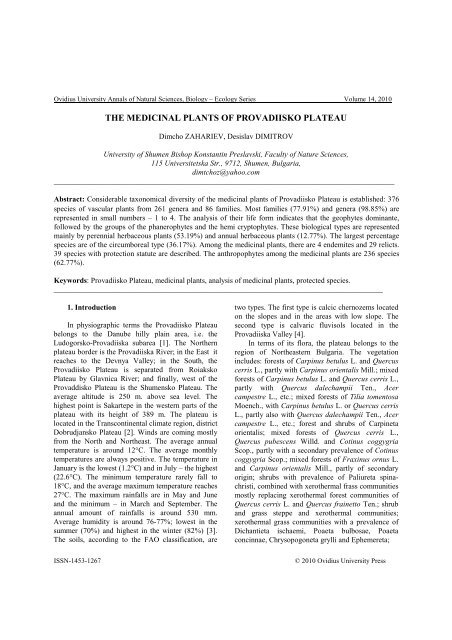VOLUM OMAGIAL - Facultatea de Ştiinţe ale Naturii şi Ştiinţe Agricole
VOLUM OMAGIAL - Facultatea de Ştiinţe ale Naturii şi Ştiinţe Agricole
VOLUM OMAGIAL - Facultatea de Ştiinţe ale Naturii şi Ştiinţe Agricole
You also want an ePaper? Increase the reach of your titles
YUMPU automatically turns print PDFs into web optimized ePapers that Google loves.
Ovidius University Annals of Natural Sciences, Biology – Ecology Series Volume 14, 2010<br />
THE MEDICINAL PLANTS OF PROVADIISKO PLATEAU<br />
Dimcho ZAHARIEV, Desislav DIMITROV<br />
University of Shumen Bishop Konstantin Preslavski, Faculty of Nature Sciences,<br />
115 Universitetska Str., 9712, Shumen, Bulgaria,<br />
dimtchoz@yahoo.com<br />
_________________________________________________________________________________________<br />
Abstract: Consi<strong>de</strong>rable taxonomical diversity of the medicinal plants of Provadiisko Plateau is established: 376<br />
species of vascular plants from 261 genera and 86 families. Most families (77.91%) and genera (98.85%) are<br />
represented in small numbers – 1 to 4. The analysis of their life form indicates that the geophytes dominante,<br />
followed by the groups of the phanerophytes and the hemi cryptophytes. These biological types are represented<br />
mainly by perennial herbaceous plants (53.19%) and annual herbaceous plants (12.77%). The largest percentage<br />
species are of the circumboreal type (36.17%). Among the medicinal plants, there are 4 en<strong>de</strong>mites and 29 relicts.<br />
39 species with protection statute are <strong>de</strong>scribed. The anthropophytes among the medicinal plants are 236 species<br />
(62.77%).<br />
Keywords: Provadiisko Plateau, medicinal plants, analysis of medicinal plants, protected species.<br />
______________________________________________________________________________________<br />
1. Introduction<br />
In physiographic terms the Provadiisko Plateau<br />
belongs to the Danube hilly plain area, i.e. the<br />
Ludogorsko-Provadiiska subarea [1]. The Northern<br />
plateau bor<strong>de</strong>r is the Provadiiska River; in the East it<br />
reaches to the Devnya Valley; in the South, the<br />
Provadiisko Plateau is separated from Roiaksko<br />
Plateau by Glavnica River; and finally, west of the<br />
Provaddisko Plateau is the Shumensko Plateau. The<br />
average altitu<strong>de</strong> is 250 m. above sea level. The<br />
highest point is Sakartepe in the western parts of the<br />
plateau with its height of 389 m. The plateau is<br />
located in the Transcontinental climate region, district<br />
Dobrudjansko Plateau [2]. Winds are coming mostly<br />
from the North and Northeast. The average annual<br />
temperature is around 12°С. The average monthly<br />
temperatures are always positive. The temperature in<br />
January is the lowest (1.2°С) and in July – the highest<br />
(22.6°С). The minimum temperature rarely fall to<br />
18°С, and the average maximum temperature reaches<br />
27°С. The maximum rainfalls are in May and June<br />
and the minimum – in March and September. The<br />
annual amount of rainfalls is around 530 mm.<br />
Average humidity is around 76-77%; lowest in the<br />
summer (70%) and highest in the winter (82%) [3].<br />
The soils, according to the FAO classification, are<br />
two types. The first type is calcic chernozems located<br />
on the slopes and in the areas with low slope. The<br />
second type is calvaric fluvisols located in the<br />
Provadiiska Valley [4].<br />
In terms of its flora, the plateau belongs to the<br />
region of Northeastern Bulgaria. The vegetation<br />
inclu<strong>de</strong>s: forests of Carpinus betulus L. and Quercus<br />
cerris L., partly with Carpinus orientalis Mill.; mixed<br />
forests of Carpinus betulus L. and Quercus cerris L.,<br />
partly with Quercus d<strong>ale</strong>champii Ten., Acer<br />
campestre L., etc.; mixed forests of Tilia tomentosa<br />
Moench., with Carpinus betulus L. or Quercus cerris<br />
L., partly also with Quercus d<strong>ale</strong>champii Ten., Acer<br />
campestre L., etc.; forest and shrubs of Carpineta<br />
orientalis; mixed forests of Quercus cerris L.,<br />
Quercus pubescens Willd. and Cotinus coggygria<br />
Scop., partly with a secondary prev<strong>ale</strong>nce of Cotinus<br />
coggygria Scop.; mixed forests of Fraxinus ornus L.<br />
and Carpinus orientalis Mill., partly of secondary<br />
origin; shrubs with prev<strong>ale</strong>nce of Paliureta spinachristi,<br />
combined with xerothermal frass communities<br />
mostly replacing xerothermal forest communities of<br />
Quercus cerris L. and Quercus frainetto Ten.; shrub<br />
and grass steppe and xerothermal communities;<br />
xerothermal grass communities with a prev<strong>ale</strong>nce of<br />
Dichantieta ischaemi, Poaeta bulbosae, Poaeta<br />
concinnae, Chrysopogoneta grylli and Ephemereta;<br />
ISSN-1453-1267 © 2010 Ovidius University Press





